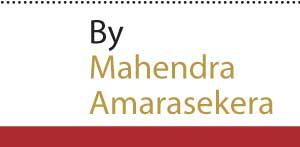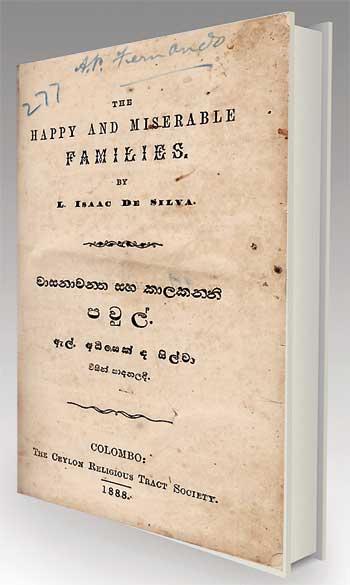02 Nov 2020 - {{hitsCtrl.values.hits}}
Sri Lanka’s forgotten literary genius
Recently, when a popular television quiz show asked to name the first Sinhala novelist, the answer was  erroneously stated as Simon de Silva, and the novel as ‘Meena’. The host however was doubtful of the accuracy of this answer, and said as far as he could recall it was a writer from Moratuwa whose name he could not remember, and that the novel was ‘Wasanawantha Saha Kalakanni Pawul’. But on another quiz programme aired by the same channel on October 18, 2020 it was correctly stated that the first Sinhala novel was in fact ‘Wasanawantha Saha Kalakanni Pawul’.
erroneously stated as Simon de Silva, and the novel as ‘Meena’. The host however was doubtful of the accuracy of this answer, and said as far as he could recall it was a writer from Moratuwa whose name he could not remember, and that the novel was ‘Wasanawantha Saha Kalakanni Pawul’. But on another quiz programme aired by the same channel on October 18, 2020 it was correctly stated that the first Sinhala novel was in fact ‘Wasanawantha Saha Kalakanni Pawul’.
As there is some apparent confusion on this matter, as a surviving great grandson of the late author, I thought it fit to set the record straight.
The first Sinhala novelist was Lindamulage Isaac de Silva of Moratuwa, and the first Sinhala novel is
|
L. Isaac de Silva |
“Wasanawantha Saha Kalakanni Pawul” (The Happy and Miserable Families) published in 1888 by the Ceylon Religious Tract Society, Colombo. I am fortunate to have in my possession the original print of this novel dated May 25, 1888. The story was originally serialized in a magazine titled ‘Ruwan Maldama’ authored by Isaac for 17 years from 1866, and was brought out in book form in 1888. The original in my possession may be the only print available in the country.
L. Isaac de Silva was born in 1844 in his parental home bordering the Bolgoda Lake, at Bambigahathotupola, Moratuwa. His father was a well-known financier L. Abraham de Silva, popularly known as ‘Kasikara Thambiappu’ a nickname he earned for his practice of drying currency notes spread on a ‘Magala’ (large rush mats of yesteryear).
"S. Lindamulage Isaac de Silva of Moratuwa, and the first Sinhala novel is “Wasanawantha Saha Kalakanni Pawul” (The Happy and Miserable Families) published in 1888 by the Ceylon Religious Tract Society, Colombo"
Isaac de Silva had his schooling at the Cotta Institute, where among other subjects he studied music under an English Missionary teacher. After leaving school he tried his hand at translating popular English hymns like ‘Christ the Lord is Risen Today’. Incidentally, it is his Sinhala translation of this hymn that is still sung every Easter Sunday  in non-conformist churches in Sri Lanka. Another perennial hymn he translated is ‘O for a closer walk with Thee’, which he wished to be sung to the tune ‘Belmont’, beloved to all Scotsmen.
in non-conformist churches in Sri Lanka. Another perennial hymn he translated is ‘O for a closer walk with Thee’, which he wished to be sung to the tune ‘Belmont’, beloved to all Scotsmen.
It did not take long for Isaac to graduate from translating to composing originals. The Methodist Hymnal published in 1889 (of which I am fortunate to have an original copy) carries 69 of his hymns (originals and translations) out of a total 307 hymns. Isaac is also credited with the translation of John Bunyan’s allegorical novel ‘Pilgrims Progress’ to Sinhala circa 1864.
He also composed a verse drama ‘Ramali Kathawa’ on the evils of drinking. The play in which the male character, a besotted gambler and drunkard, comes home to witness his weeping children gathered round the dead body of their mother, has been known to send the audience reaching for their handkerchiefs. This has been performed all over the country, including the YMBA Borella. Isaac’s musical talents have been inherited by his great grandsons Anil Bharathi, Nihal Bharathi and Chanaka Perera of ‘Super Golden Chimes’ fame.
Isaac’s campaign against alcoholism led him to form the ‘Soora Sung Sangamaya’ in Moratuwa. The success of his campaign is evident in the impressive response of 10,000 signatures from people who pledged to abstain from alcohol.
Methodism and Temperance were two topics that were closest to his heart. When his doctor offered him a glass of brandy at his deathbed in 1907, Isaac had refused it saying what he eschewed during his lifetime, he would not like to take in his final hour. “To live or die is the same,” were the last words he uttered.
Some of his extensive correspondence with English missionaries, including that great Musician Ira D. Sankey, is preserved in the Library of the British Museum, where it has been subjected to research by many a Sri Lankan Scholar.
Methodists have sung his praises as a hymn writer, temperance leader, lay preacher and the first layman in the Methodist Synod. Yet his greatest claim to fame lies in the fact that he was indeed the first Sinhala novelist.
Listed below are some notable moments in recognition of the contribution of L. Isaac de Silva.
I am saddened that apart from the head stone at the family grave in the Rawatawatta, Moratuwa General Cemetery, there is nothing to commemorate this literary genius who made such a significant contribution to Sinhala Literature.
27 Nov 2024 1 hours ago
27 Nov 2024 2 hours ago
27 Nov 2024 2 hours ago
27 Nov 2024 3 hours ago
27 Nov 2024 3 hours ago